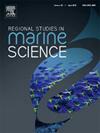人类活动对红树林表层水体重金属污染的影响评价——以张江口河口为例
IF 2.1
4区 环境科学与生态学
Q3 ECOLOGY
引用次数: 0
摘要
红树林生态系统是全球生物多样性和生产力最高的海洋生态系统之一,具有重要的生态和环境功能。然而,对红树林湿地地表水重金属污染的研究仍然有限。本研究采集了张江口河口和红树林地区24个站点的地表水和沉积物孔隙水样本。 铜(89.51±54.78 μg / L)和Pb(61.86 ±39.68 μg / L)浓度是最高的水,其次是倪(27.28 ±2.42 μg / L), Cr(19.62 ±3.64 μg / L), Hg(7.38 ±2.00 μg / L), Cd(6.61 ±0.40 μg / L)。除汞外,各重金属浓度均以研究区上下游最高,中游浓度较低。铜和铅明显受到人为来源的影响,靠近桥梁、铁路和捕鱼活动的地点的铅浓度超过总铅浓度的50% %,而河流下游和上游以及红树林区域的铜浓度占总铜浓度的30 %-74 %。主成分分析(PCA)表明,重金属的主要来源为交通和农业混合源(占62.68 %)和海水养殖污染(占37.32 %)。Cu、Pb浓度超过第三类海水水质标准,总体污染状况不佳。本文章由计算机程序翻译,如有差异,请以英文原文为准。
Assessing the impact of human activities on heavy metal pollution in mangrove wetland surface waters: A case study of the Zhangjiangkou Estuary
Mangrove ecosystems are among the most biologically diverse and productive marine ecosystems globally, with significant ecological and environmental functions. Nonetheless, research into heavy metal pollution in mangrove wetland surface waters remains limited. In this study, surface water and sediment porewater samples were collected from 24 stations within the Zhangjiangkou estuary and mangrove area. Cu (89.51 ± 54.78 μg/L) and Pb (61.86 ± 39.68 μg/L) concentration were the highest in water, followed by Ni (27.28 ± 2.42 μg/L), Cr (19.62 ± 3.64 μg/L), Hg (7.38 ± 2.00 μg/L), Cd (6.61 ± 0.40 μg/L). With the exception of Hg, the concentrations of all heavy metals were highest in the upstream and downstream of the study area, with lower concentrations observed in the middle reaches. Cu and Pb are clearly influenced by anthropogenic sources, with Pb concentrations at locations proximal to bridges, railways, and fishing activities exceeding 50 % of the total Pb concentration, while Cu concentrations in the downstream and upstream of the river and areas within mangrove forests accounted for 30 %-74 % of the total Cu concentration. Principal component analysis (PCA) suggests that the primary sources of heavy metals were transportation and agriculture mixed sources (accounting for 62.68 %) and mariculture pollution (accounting for 37.32 %). Cu and Pb concentration exceeded the third category seawater quality standards, highlighting an overall unfavorable pollution status.
求助全文
通过发布文献求助,成功后即可免费获取论文全文。
去求助
来源期刊

Regional Studies in Marine Science
Agricultural and Biological Sciences-Ecology, Evolution, Behavior and Systematics
CiteScore
3.90
自引率
4.80%
发文量
336
审稿时长
69 days
期刊介绍:
REGIONAL STUDIES IN MARINE SCIENCE will publish scientifically sound papers on regional aspects of maritime and marine resources in estuaries, coastal zones, continental shelf, the seas and oceans.
 求助内容:
求助内容: 应助结果提醒方式:
应助结果提醒方式:


